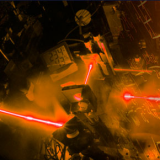
The Quantum Information Science and Technology Laboratory (QISTL), a key component of the NSF’s Interdisciplinary Quantum Information Science and Engineering (iQuISE) graduate training program at MIT, opened this April for lab tours and hands-on lab visits. Located in 26–368, QISTL is a state-of-the-art quantum optics laboratory that is designed to offer students practical experience in quantum optical information.
The current setup features research grade equipment, including two single photon detectors, a CCD camera, coincidence counters and a nonlinear crystal for photon pair production by spontaneous parametric down-conversion. The experiment itself relies on a simple linear-optical arrangement and, as such, is easily reconfigured to demonstrate and explore different aspects of entanglement and other QIS properties. This setup was first utilized in summer 2011 for QuISU, a summer enrichment program on Quantum Information Science for undergraduates.
QISTL offers three levels of QIS lab experience to iQuISE associates:
- A 2‑hour lab tour highlights the basic concept and experimental observation of generating a pair of photons, the so-called Hong-Ou-Mandel (HOM) quantum interference measurement to measure distinguishability of two photons, a simple method for generating polarization-entangled photons post-selectively using a beam splitter, and two-photon quantum interference measurements in two mutually unbiased bases to verify polarization entanglement.
- An in-depth hands-on lab experience allows 2‑student teams to use the same setup and perform their own measurements to explore various experimental aspects of indistinguishability and entanglement. One measurement of particular interest is the Clauser-Horne-Shimony-Holt (CHSH) form of Bell’s inequality can be performed in this in-depth laboratory setting. These experiments spans two to three 4‑hour sessions.
- At the third level of participation, it is also possible for one or two highly motivated iQuISE associates to engage in the maintenance and upgrade of QISTL.
Two lab tours have already been conducted, on April 9th and 20th. Students who have taken the tours found the presentation to be very enjoyable and instructive in understanding various aspects of quantum entanglement. Several 2‑student teams, including theory-oriented students, have been formed to conduct hands-on experiments after the end of Spring semester.
For more information on the lab or to sign up for a lab tour or in-depth lab experience, contact Franco Wong (ncw@mit.edu) or Kristi Beck (kbeck@mit.edu). Preference is given to current iQuISE associates.
Related Links:
Interdisciplinary Quantum Information Science and Engineering (iQuISE)
